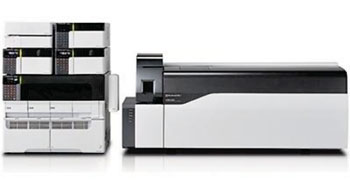Sensitive Estrogen Detection Method Developed
By LabMedica International staff writers
Posted on 14 Jan 2015
The hormone estrogen plays an important role in the human body and has been linked to everything from tumor growth to neuron loss during Alzheimer's disease, but detecting very small amounts of it in blood and other biological fluids can be difficult, especially in the limited amounts available in laboratory studies.Posted on 14 Jan 2015
A new method for detecting trace amounts of estrogen has been developed that uses liquid chromatography-mass spectrometry (LC-MS) and tandem mass spectrometry (LC-MS/MS) which remains the most sensitive and specific technique for both quantitative and qualitative analysis of small molecules in biological samples.

Image: The liquid chromatography–mass spectrometry LCMS-8050 triple quadrupole mass spectrometer (Photo courtesy of Shimadzu Corporation).
Scientists at the University of Texas (Arlington, TX, USA) developed a method for ultra-trace determination of estrogens in human serum using a combination of charged bulk derivatization and weak cation exchange (WCX) RAM-based trap-and-elute LC–MS/MS. The LC system was equipped with four pumps (Pump A/B: LC-30AD, Pump C/D: LC-20AD XR), a SIL-30AC AS, and a CTO-30A column oven containing a 2-position six-port switching valve. The analyses have been performed with a prototype WCX RAM trap column (Shimadzu Corporation; Kyoto, Japan). The LC–MS/MS analysis was performed on a Shimadzu LCMS-8050 triple quadrupole mass spectrometer.
Mass spectrometry and chromatography are ways to separate, identify, and quantify molecules in a complex mixture. The process involving liquid chromatography-electrospray ionization-tandem mass spectrometry relies on a vital step called charge derivatization or using a permanently charged reagent to selectively trap the estrogens and isolate them from the lipids and proteins that could interfere with estrogen detection. The limits of detection (LODs) in the study were found to be 3 pg/mL for estriol, 7 pg/mL for estrone and 17α-estradiol, and 5 pg/mL for 17β-estradiol. The new method can be accomplished in less than 25 minutes, including sample preparation and was a sensitive and efficient method for detecting trace amounts at less than 10 parts per trillion in a 100 mL sample.
Jose A. Barrera, PhD, director of the Shimadzu Institute and a coauthor of the study, said, “This new method pushes the detection limit for estrogens to a level that is applicable to research, human health, medicine, and environmental analysis. Its being instituted as a routine service means that all scientists now have the capability to more closely relate research model findings to human health and physiology.” The study was published on November 27, 2014, in the journal Analytica Chimica Acta.
Related Links:
University of Texas
Shimadzu Corporation













